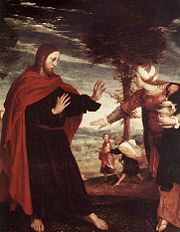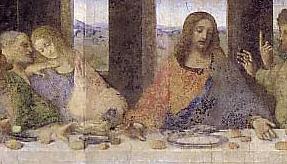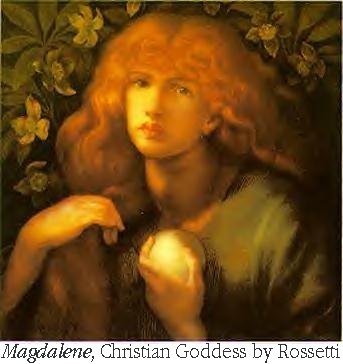
The Order of the White Moon Presents:
Mary Magdalene: Goddess Among Us
by Mehitabel
Mary Magdalene - sinner, saint or Goddess? However we view her, Mary Magdalene is a figure of our time, a source of inspiration and hope. Highlighted by the book and film “the Da Vinci Code”, there is much circumstantial evidence suggesting that Mary Magdalene was the bride of Yeshua (Christ) and that together they had at least one child.. This radical view has attracted a growing number of adherents and I would recommend that all interested begin with Margaret Starbird's books on the subject. In this summary I draw on her works, on the works of Joan Norton and the works of Michael Baigent and colleagues. I also wish to acknowledge the Northway School and the Prioress Katia of the Church of the Way.
The biblical story mentions Mary Magdalene as a minor character, a sinner from whom Yeshua cast out seven devils, and yet it was Mary Magdalene who stood vigil at Golgotha when all the male disciples had vanished; it was Mary Magdalene and Mother Mary who tended Yeshua in those final hours and who prepared Him for burial; and it was to Mary Magdalene that Yeshua reappeared at the resurrection tasking her, not the male disciples, to spread the Good News; a strange responsibility for a minor character and sinner. Even within the biblical concept there are questions as to Mary Magdalene's identity. Was she Mary of Bethany, sister of Lazarus, or someone different? Theology experts remain divided on this score.

Let us look at the story in a different way. The pattern of a dying and resurrecting God and a grieving Goddess has been repeated in pantheons of deities the world over, and particularly among the cultures of the Near and Middle East. Here we have Isis and Osiris; Ianna and Tammuz, and Cybelle and Attis. These are tales of sacred union, the heiros gammos.. It is the absence of the sacred marriage in the Judao-Christian faith that drew Margaret Starbird to the mystery of Mary Magdalene. A staunch Roman Catholic, she writes a very personal account of how she came to realise, through what could only have been divine guidance, that there was something fundamental missing from the Christian Faith and this was the feminine counterparts for Yeshua and for Yahwez. She shows, convincingly, how the restoration of the divine feminine restores the sacred balance that is missing in our world.

It is beyond the scope of this project to explore all the theories associated with Mary Magdalene and her role in the life and death of Yeshua and the copious supporting evidence. Suffice here to present a simple hypothesis. Mary Magdalene, Mary of Bethany (sister of Lazarus) and the woman with the alabaster jar are all the same person. This lady was born of the House of Judah, and her alliance with Yeshua would be politically opportune and would unite her House with that of David. Yeshua himself was a political figure and such an alliance would have been important. Let us consider the woman with the alabaster jar who anointed Yeshua with such love, to be Mary herself sharing the precious unguent with her intended. Such jars of perfume were carried by women of good families as a form of dowry. Let us also consider Mary to be a priestess of Ianna, and the seven sins cast out by Yeshua to be the seven veils through which the priestess travelled in ceremony. Let us also consider the sacred marriage, where the priestess of Ianna would couple with the political leader in Hieros Gamos in an important ceremony, and further cement this in civil partnership. Let us consider how Mary stayed with Yeshua through the ordeal of the trial and the crucifixion, how she tended his body with the love of a wife and how He appeared to her alone at the resurrection. It was Mary he tasked with continuing His work, surely the act of a husband encouraging his wife to continue without him. And finally, let us consider Mary to be carrying Yeshua's child, the precious bloodline of the vine; that most special life whom she protected by fleeing to first Egypt and then France. The sources cited above are highly recommended and consider all the theories in detail.
Whether we view Mary Magdalene as sinner, saint or Goddess, she represents a return of the divine feminine. In viewing her as Goddess we restore the sacred balance of this world, we reinstate the virtues of the female which are sadly missing from our world, virtues such as peace, compassion, pure love, loyalty and honour, and, with them, healing and hope. This is achieved through the hieros gamos, the sacred marriage, that most Holy Union. Through Mary, we empower all women, we release the Goddess within us, and we restore the balance between man and woman in society.

In Mary, we find the lost Goddess and through her we find our true selves. It is time to release the Goddess, to restore the balance and to save our society and the world. Let Mary act as our guide, and let us find success through her. Blessed be!
Images:
Hans Holbein's Noli Me Tangere (do not touch me) of the resurrection and the appearance of Yeshua to Mary Magdalene (www.wikepedia.com )
Da Vinci's last supper showing Mary adjacent to Yeshua (www.northway.org)
Rosetti's picture of Mary Magdalene (www.northway.org )